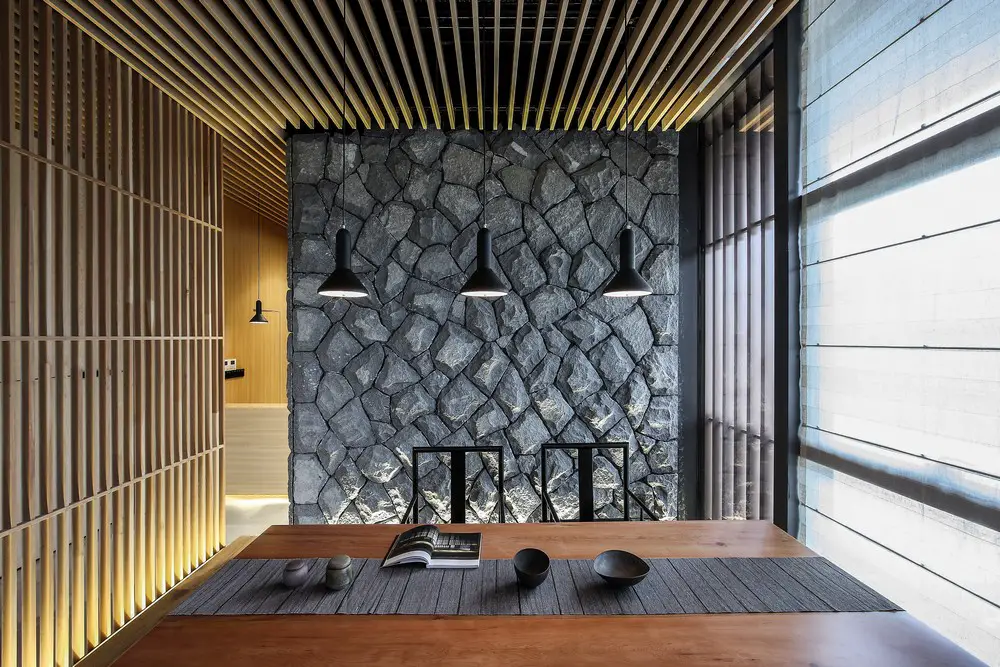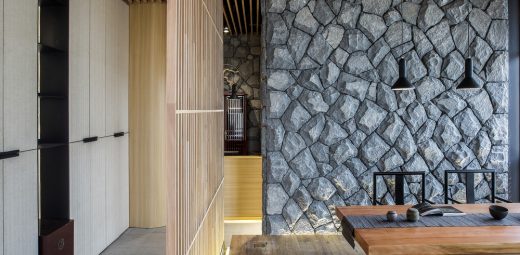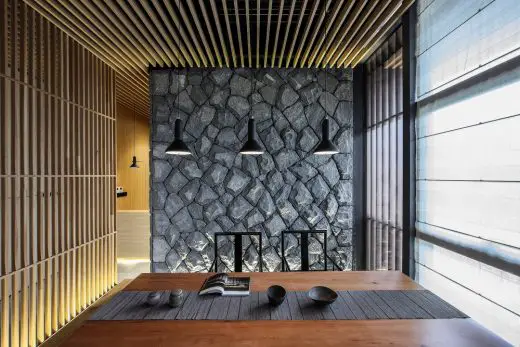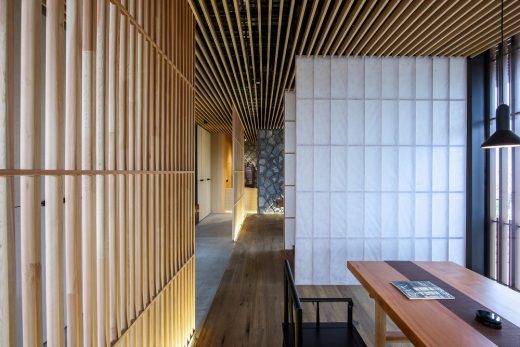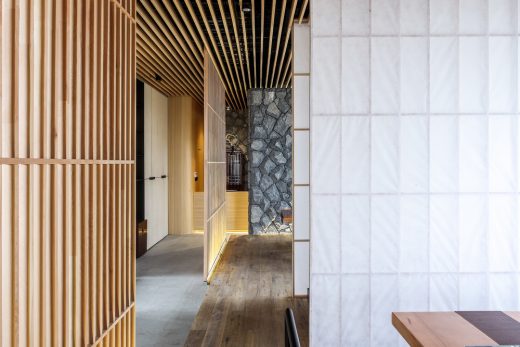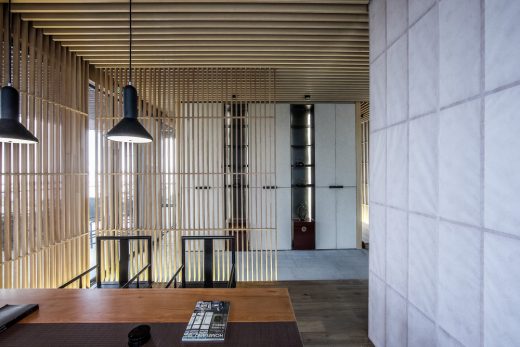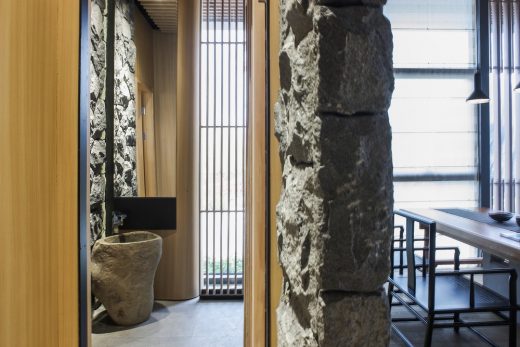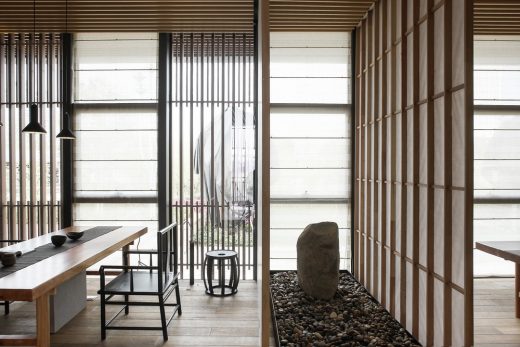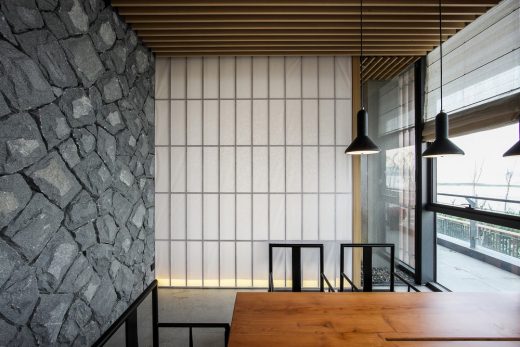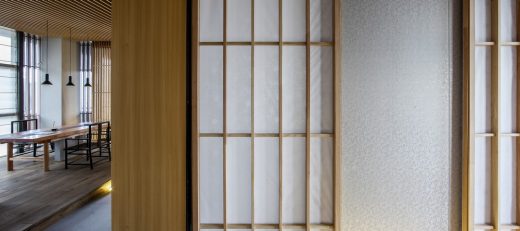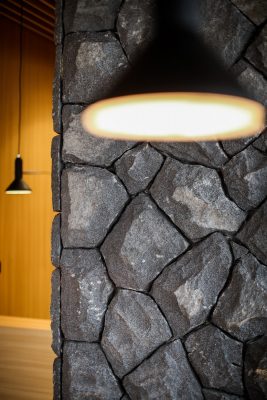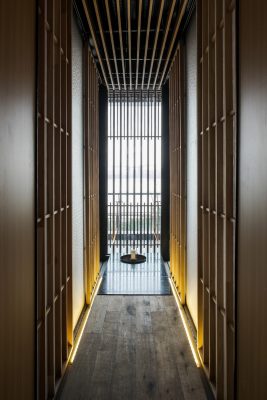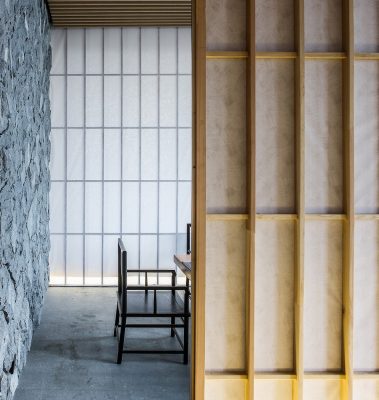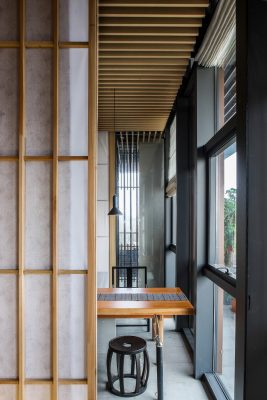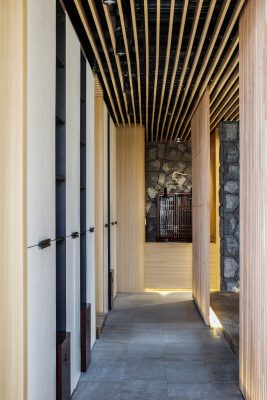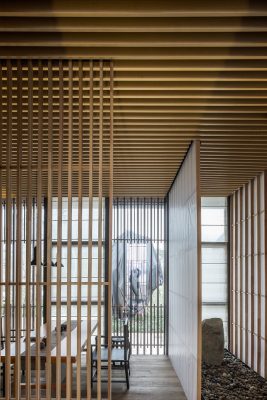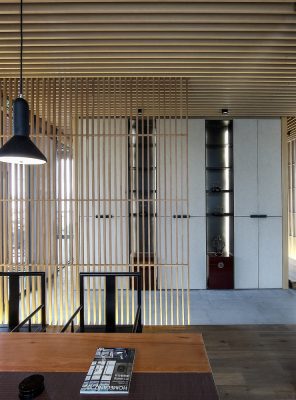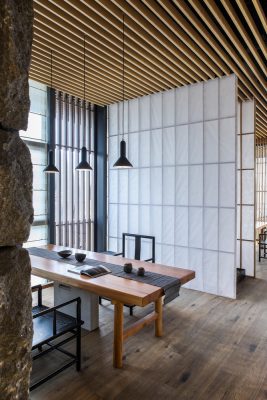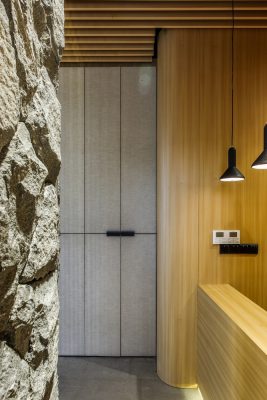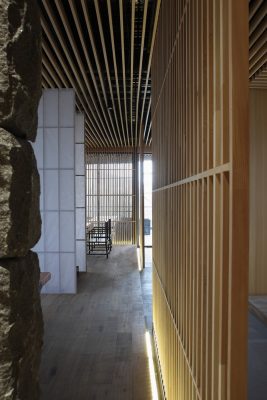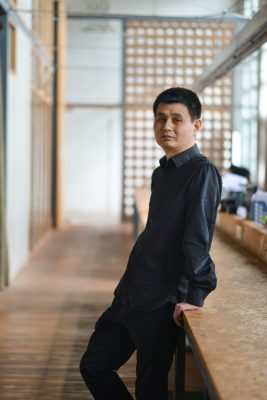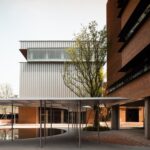Riverside Teahouse in China, Fuzhou Building, Red Dot Award, Min River Interior Images
Riverside Teahouse, Fuzhou
Chinese Interior: Min Jiang Architecture, China – by Lin Kaixin Design, architects
20 Oct 2016
Riverside Teahouse on the Min Jiang in Fuzhou
Location: Min River, Fuzhou, Fujian, China
The Min River or Min Jiang is a 735-kilometer-long river (457 mi) in central Sichuan province, China.
Architects: Lin Kaixin Design
Riverside Teahouse Wins Prizes at 2016 Red Dot Awards and 2016 iF Awards
茶·舍
Teahouse
设计:林开新、陈晓丹 文:张丽芳 摄影:吴永长
Designer: Lin Kaixin, Chen Xiaodan, Writer: Zhang Lifang, Photographer: Wu Yongchang
导语:在江滨茶会所中,会所和江水,一者轻吟,一者重奏;一者灵动,一者厚重;一者当代,一者古老。当两者被有机结合在一起时,它们已经不是相互独立的个体,而是一个丰富的整体。
Introduction: In the riverside teahouse, the teahouse is whispering, smart and contemporary, whereas the river is running, thick and ancient. When the two are in organic combination, they are no longer independent individuals, but one in whole.
“大江东去,浪淘尽,千古风流人物。”浩浩荡荡的江水,如同一部鸿篇巨制的史书,裹挟着数不尽的风云往事和千古情愁。当客户在委托林开新做此项目的设计,说:“我想在闽江边上,公园之中,建一个私人会所,闲时与朋友喝茶聊天,累时可放松心情”时,林开新脑海中浮现的是江上鸣笛的诗意场景,“笛子是一个象征,它实际上是一种空间的节奏。我希望这个茶会所的格调像笛声般优雅婉转,又悠远绵长” ,一向秉持“观乎人文,化于自然”理念的林开新说道。
“The major river flows eastward, with its huge waves are gone all those gallant heroes of bygone years.” The might river is like a masterwork of history, containing countless stories and melancholies. When listening to the client’s description of his idea, “I’d like to build a private club in the park along Minjiang River to drink tea with drinks in leisure time while relax myself when feel tired”, what emerged in Lin Kaixin’s mind was a poetic scene of playing flute near the river. “Flute is symbol. It is actually a spatial rhythm. I hope the style of this teahouse is as elegant, lingering as flute melody.” said Lin Kaixin, who has been adhering to the concept of “observe humanities, integrate into nature”.
整体的设计在追求达至东方文化的圆满中展开——将中庸之道中的对称格局、建筑灰空间的概念巧妙结合,完美呈现出一个自由开放、自然人文的精神空间。以一种柔软而细腻的轻声细语,与浩瀚的江水、优美的园林景观互诉衷肠,相互辉映,和谐共生,而非封闭孤立的沉默无声或张扬对抗的声嘶力竭。
The overall design starts in the pursuit of achieving completeness of the oriental culture, which skillfully combines the concepts of symmetrical patterns, architectural gray space to perfectly present a free, open, natural and humane spiritual space. In a soft and delicate whisper, the teahouse complements with the vast river, beautiful landscape, achieves harmonious co-existence, rather than a closed or isolated silence or assertive confrontation.
茶会所临江而设,客人需沿着公园小径绕过建筑外围来到主入口。整体布局于对称中表达丰富内涵。入口一边为餐厅包厢和茶室,一边为相互独立的两个饮茶区域。为了保护各个区域的隐私性,增添空间的神秘氛围,设计师设置了一系列灰空间来完成场景的转换和过渡,令室内处处皆景。首先是饮茶区中间过道的端景。地面采用亮面瓷砖,经由阳光的折射,如同一泓池水,格栅和饰物的倒影若隐若现。窄窄的过道显得深邃幽长,衍生出一种宁静超然的意境。其次是餐厅包厢和茶室中间过道的端景。大石头装置立于碎石子铺就的地面之上,引发观者对自然生息、生命轮回问题的思考。在靠近公园走道的两个饮茶区,设计师分别设置了室外灰空间和室内灰空间。室外灰空间为一喝茶区域,除了遮阳避雨所需的屋檐之外,场所直接面向公园开放,在天气宜人、景色优美的四至十月,这里将是与大自然亲密接触的理想之地。在另一边饮茶区,设计师以退为进,采用留白的手法预留了一小部分空间,营造出界定室内外的小型景观。端景的设计不仅丰富了室内的景致,而且增添了空间的层次感和温润灵动的尺度感。
The teahouse is built in the riverside and guests need to go to the main entrance along the park path and bypass the building envelope. The overall layout expresses rich content in symmetry. One side of the entrance is restaurant balcony and teahouse and the other side is two independent drinking areas. To protect the privacy of each region and add the mysterious spatial atmosphere, the designer has set up a series of gray space to complete the conversion and transition scenes, making endless indoor landscapes. The first is the scene in the middle aisle of the drinking area. The ground is covered by glossy tiles, which looks like a pool of water via the refraction of sunlight, with looming reflection of grill and accessories. Narrow aisle seems deep and profound, revealing a kind of transcendent and serene artistic conception.
The second is the scenery in the aisle between the restaurant balcony and tea room. There is a big stone standing on gravel paved ground, evoking the reflection on nature and life cycle. In the two tea areas near the park walkway, designers set up outdoor gray space and indoor gray space respectively. Outdoor gray space is a tea drinking area. In addition to the roof for sunshade and rain shelter, the place is directly open to the park. From April to October with amiable weather and charming scenery, here will be an ideal place for imitate contact with nature. In the tea drinking area on the other side, designers reserved a small portion of space in blank to create a small landscape to separate the indoor and outdoor areas. The design of end scenery does not only enrich the indoor landscape but also adds a sense of depth, warm and smart sense of scale.
在设计语言的运用上,设计师延伸了建筑的格栅外观,运用细长的木格栅,而非实体的隔墙界定出各个功能“盒子”。即便在洗手间,观者依然可以通过格栅欣赏公园景观,时刻感受自然的气息。格栅或横或竖,或平或直,于似隔非隔间幻化无穷,扩大空间的张力。格栅之外,障子纸和石头亦是空间的亮点。在灯光的烘托下,白色障子纸的纹理图案婉约生动,别有一番自然雅致之美。石头墙的设计灵感来源于用石头垒砌而成的江边堤坝,看似大胆冒险却完美地平衡了空间的柔和气质,令空间更立体更具生命力。在这个模糊了自然和人文界限,回归客户本质需求的空间中,每一个人都可以在此放飞思绪尽情想象,也可以去除杂念凝思静想。
In the use of design language, the designer extended the building grille appearance to design various functional “boxes” by slim and long wood grills rather than solid partition wall. Even in the bathroom, the viewer can still enjoy the park view via the grills to feel the natural atmosphere. Horizontal or vertical grills, flat or straight grills produce infinite changes to expand the spatial tension. Outside of the grill, shoji paper and stone are also space highlights. In the contrast of light, the white shoji paper has graceful and vivid patterns, revealing special natural and elegant beauty. The stone design inspiration came from the riverside embankment, seemingly daring adventure yet perfectly balanced the spatial soft temperament, making it more three-dimensional and have more vitality. In this space blurring natural and cultural boundaries while returning to the space of the true needs of guests, everyone can enjoy free imagination and also meditation without distractions.
Riverside Teahouse Sichuan – Building Information
项目名称:江滨茶会所 。
项目面积:224 ㎡ 。
完工时间:2015年1月。
设计公司:林开新设计有限公司。
主持设计师:林开新 。
参与设计师:陈晓丹。
主要材料:桧木、障子纸、松木、贴木皮铝合金、灰姑娘石材。
摄影师:吴永长。
Project name: Riverside Teahouse
Project area: 224 ㎡ 。
Completion time: Jan., 2015
Design company: Lin Kaixin Design Co., Ltd.
Presiding designer: Lin Kaixin
Participating designer: Chen Xiaodan
Main materials: Cypress, Shoji paper, pine, aluminum veneer, Cinderella stone
Photographer: Wu Yongchang
Lin Kaixin Designer:
Riverside Teahouse Fuzhou images / information from Architects Lin Kaixin Design
Website: Lin Kaixin Design, China
Location:Fuzhou, Fujian, China
Architecture in China
China Architecture Designs – chronological list
Chinese Architect Studios – Design Office Listings
Chinese Tea House Buildings
Bamboo Courtyard Teahouse, Yangzhou, eastern China
Design: Harmony World Consulting & Design (HWCD)
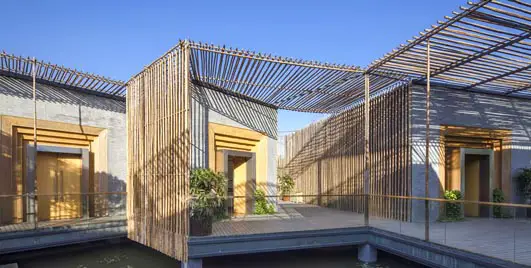
photograph : T+E
Bamboo Courtyard Teahouse
Tea House in Hutong, East District, Beijing, northern China
Design: ARCHSTUDIO
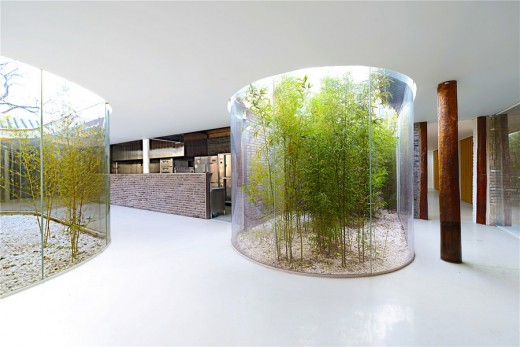
photo from architects
Chinese Tea House in Hutong
Tea House, Shanghai, Jungong Road, Yangpu District, Shanghai, eastern China
Design: Archi-Union Architects
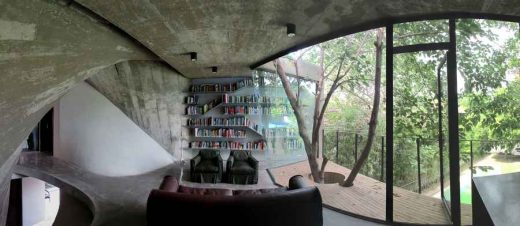
photograph : Zhonghai Shen
Tea House Shanghai
Tea House Architecture
Boa Nova Tea House, Portugal
Design: Álvaro Siza Vieira
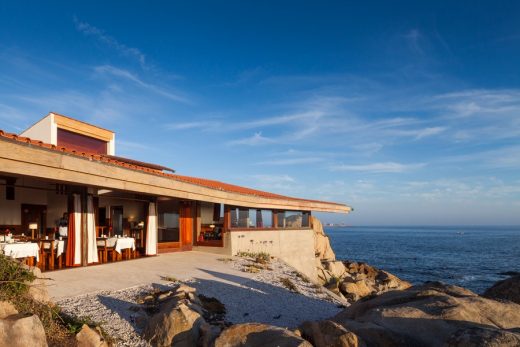
photograph : Joao Morgado
Boa Nova Tea House
Tea Houses California, Silicon Valley, California, USA
Design: Swatt | Miers Architects
![]()
photograph : Tim Griffith
Tea Houses California
El té – Brazilian Tea House, Porto Alegre, Brazil
Design: Gustavo Sbardelotto & Mariana Bogarin
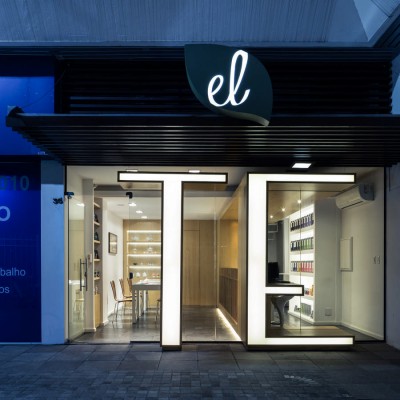
photo : Marcelo Donadussi
El té Tea House
Tea House, Vreeland, Holland
Design: UNStudio
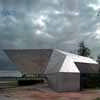
photo from architects
Dutch Tea House Building
‘Sliced Porosity Block’
Design: Steven Holl Architects
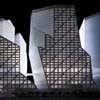
image : Iwan Baan
Chengdu building complex : For CapitaLand China
Bird’s Nest – Chinese National Stadium Building
Design: Arup, Herzog & De Meuron, China Architecture Design & Research Group
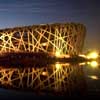
photo © Arup_Ben McMillan
Birds Nest Beijing
Chengdu Museum building
Design: Sutherland Hussey Architects
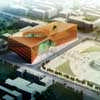
image from architect
Chengdu Museum building
Beijing Olympics – The Water Cube
PTW with Arup
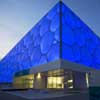
photo © Arup_Ben McMillan
Water Cube Beijing
Website : Tea House
Fuzhou Yimeijia Building Materials Co Offices in Fujian
Architects: Lin Kaixin Design
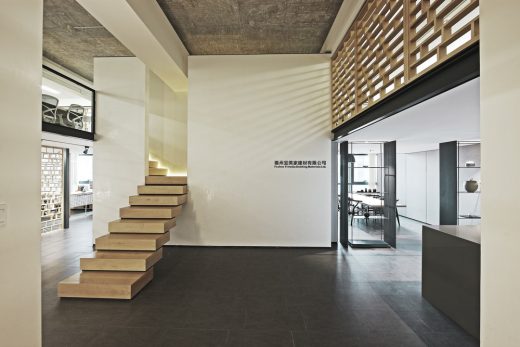
photo from architects
Fuzhou Yimeijia Building Materials Co – 24 Oct 2016
Comments / photos for the Riverside Teahouse, Sichuan – Min River Building page welcome
Riverside Teahouse Sichuan – page
Website : Min Jiang

